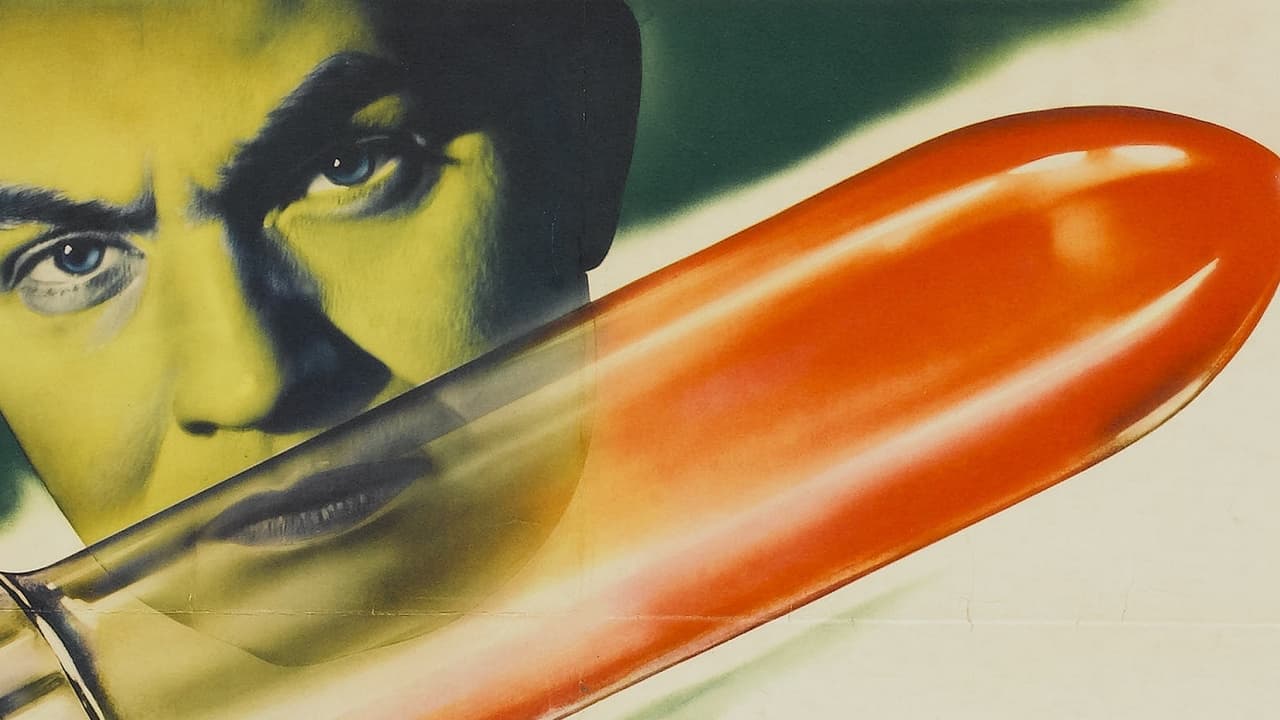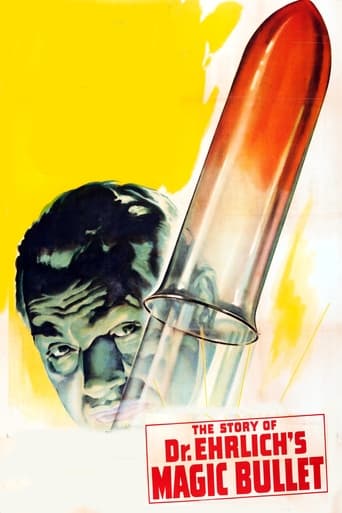

Charming and brutal
... View MoreA Disappointing Continuation
... View Moreit is the rare 'crazy' movie that actually has something to say.
... View MoreThis movie feels like it was made purely to piss off people who want good shows
... View MoreSober, respectful, beautifully photographed, impeccably acted, reasonably dramatic, skilfully directed, but lacking some of the fire and passion of earlier Warner biographies like Pasteur and Zola. In fact, in many ways, Ehrlich is a sort of watered-down Pasteur. Once again, the conflict lies between the scientist and an ultra-conservative medical profession. In theory, Ehrlich should have been even more forceful because it introduces an additional conflict: Jew versus Gentiles. But in practice, these two conflicts counteract instead of reinforcing each other. The reason is that the film's makers seem peculiarly afraid to call a spade a spade. Oh, they can bandy words like "syphilis" around all right (but significantly without once alluding to the fact that it is a sexually transmitted disease — in fact Ehrlich actually says in one scene that the disease can be contracted by other means), but when it comes to calling Ehrlich a Jew, the best the writers can manage is an oblique reference to Ehrlich's "faith" in a report from Rumann to Love. It's a reference that few moviegoers will even notice, let alone appreciate. Yet the writers obviously see the Rumann character as a crystallization of anti-Jewish sentiment in Germany, with obvious contemporary parallels. But they don't actually come right out and say so. They hint. They speak slyly to those few picturegoers that are in the know. There were doubtless good political reasons for this. But all this hiding behind a veil, waters down the essential drama. What we have left is a conflict between a big team of experts led by Ehrlich and a few disgruntled, ignorant but powerfully-placed bigots. Not exactly the stuff of high drama. A bit of tension there certainly, but 250 volts compared to a possible 25,000.These restraints in the scripting are echoed by the players. In the key central role, Robinson's acting can be, was and is justly described as restrained. That's fine. But is restraint what his fans expect and want? To my mind, Edward G. Robinson stands for full- blooded power, charismatic playing with all gloves off. This dignified, selfless, persistent, undiscouraged, turn-the-other-cheek Ehrlich is not the Robinson we know and love. In short, a very classy production, with marvelous technical credits, always very appealing to look at (a special bow to Perc Westmore for his wholly credible make-up work on Robinson), but one that seems, despite good pacing and attractive production values, to be operating at half-steam. Robinson dominates the film. Aside from the ever-reliable Otto Kruger and the hissingly villainous Sig Rumann and Montagu Love, most of the other players, talented as they are, fail to get much of a look-in . Even Madame Ouspenskaya figures in only a couple of scenes. OTHER VIEWS: Among all the plays and films in which I've appeared, I'm proudest of my role in Doctor Ehrlich's Magic Bullet. It was, I think, one of the most distinguished performances I've ever given. I say that not only because the critics said it and the mail and the box office said it, but most of all because that inner voice, that inner self, that captious critic Emanuel Goldenberg said it. And others said it, people who, in the end, meant the most: Dr Ehrlich's family. — Edward G. Robinson.
... View More"Dr. Ehrlich's Magic Bullet" is a movie with a paradoxical goal: it wants to convince us not to be ashamed of something that the movie is obviously ashamed of.It begins with a prologue informing us of the fact that the movie is based on a true story, explaining that it was the goal of Dr. Paul Ehrlich to develop chemicals that would treat diseases, which he called "magic bullets," to treat the "scourges" of mankind. No mention is made of the particular scourge that this movie is about, which is syphilis. Already, we get the first indication of reticence on the part of the movie to actually mention the word "syphilis."In the first scene, a young man enters Ehrlich's office for a physical examination. As with the prologue, Ehrlich does not utter word "syphilis," referring to it as a contagious disease, and then, incredibly enough, adding that it is "an infection just like any other." Inasmuch as the unmentioned syphilis was, at that time, an often fatal, neurological degenerative disease, what are we to make of this inappropriately reassuring phrase, "an infection just like any other"? A clue to what he is getting at comes with the following remark, "I've seen cases where it was transmitted by an inanimate object."In other words, most people get syphilis through sexual intercourse, which makes the disease shameful. Therefore, to separate the disease from the shame, Ehrlich is making excuses for the patient's condition, indicating that he might have contracted it in some manner other than sex. Hence the phrase, "an infection just like any other." Of course, we all know that this young man probably had sex with a prostitute. So, in the very act of telling him (and us) that the disease whose name he won't utter might have been contracted in a non-shameful manner, he is implicitly saying that the vast majority of cases of syphilis, which are contracted through sex, are not infections just like any other, but are in fact something to be ashamed of.After the examination, we see Ehrlich putting some substance into a jar for the man to apply to his skin. He picks up a label, holding it between his thumb and fingers, licks the label, and applies it to the jar. Now, how's that for an inanimate object? In the very act of licking something his hands just touched right after examining the patient, he makes it hard for us to take him seriously about alternate means of transmission.He lies to his patient that some people are cured, but the man does not believe him, and while supposedly getting dressed, the patient commits suicide, apparently slitting his own throat with a scalpel. Needless to say, nothing like that ever actually happened, but exists solely for its melodramatic value. Later, Ehrlich tells his wife Hedwig that the man is better off dead, and the world is better off because he cannot infect anyone. He despairs that all the treatments he prescribes are useless, just something to give patients a false sense of hope.From this point, the movie follows Ehrlich through various medical discoveries. As is typical in movies about scientists, the role of accident is emphasized, "Eureka!" situations, as it were. Such accidents do occur in science, of course, but they are given more significance in the movies than they really deserve, because they have more dramatic value than the norm of dull, plodding science that moves from one carefully controlled experiment to another. The movie further provides us with an Arrowsmith situation, specific to medical science, in which the experiment requires that half the subjects get the serum or vaccine while the control group gets only a placebo or nothing at all; but in the name of humanity, the doctor ends up giving everyone the medicine, which saves their lives. Of course, in these dramatic situations, there is always a de facto control group anyway, which is all the people who were dropping dead from the disease prior to the experiment.In any event, about one hour in, the word "syphilis" finally makes its way into the movie. And now, what he once referred to as "an infection just like any other," he calls "man's most vicious disease." At a dinner party, when asked what he is working on, he shocks the guests by uttering the word "syphilis." Anxious to reassure the guests, he returns to the earlier dodge of saying that this disease can be transmitted by an ordinary object like a drinking cup or eating utensil. We see that Ehrlich is once again trying to remove the shame of syphilis with his reference to alternate forms of contracting the disease, which he refers to as "innocent ways." In so doing, however, he implies that there are guilty ways of contracting syphilis, which are by far the most common, such as by whoring around.Eventually, he develops Compound 606, later to be marketed as Salvarsan, a compound that allows arsenic to kill the spirochete bacterium without harming the test animals. We then get the trope of the scientist that experiments on himself, when one of Ehrlich's staff injects himself with the compound to see if it is safe for humans. Following this, we get another Arrowsmith situation, in which Ehrlich allows Compound 606 to be made available to doctors before he is through testing it, sacrificing strict scientific procedure for the sake of the dying patients. As a result, a few patients die, leading to accusations against Ehrlich, who in turn sues for libel. This is most fortunate, from a cinematic standpoint, because a trial is also a good way to dramatize science.In the end, however, Dr. Ehrlich was more successful in his struggle to defeat syphilis than the movie was in its struggle to defeat the shame that comes from contracting it.
... View MoreThough a comment was previously deleted; likely because of the mention of the common name of a disease prominent to the time (I can hazard, no other guess as to the reason); this must really be a unique movie, and I will be on the edge of my seat to view it again and possess the disk for further viewings. It broke the mold for the Hayes censor board with the-then unpardonable mention of Lue's. For Dr. Erlich to persist through 606 compilations is astonishing.An interesting "medical" maxim bringing levity to observers of hip radiographs in some oldsters even as late as the 1960's; often a radiolucent area was noted at the injection sites of the arsenical/mercurial. We used to say, "One night with Venus, and seven years with Mercury," a reference to "exposure" and the subsequent treatment and its length of time and the signs left behind.
... View MoreWell made and accurate film illustrating the great efforts Dr. Ehrlich made in strict scientific method and his ability to comprehend disparate events. This culminated in Dr. Ehrlich's nearly single-handed development of cytology, histology, hematology, hypothesis of immunity and antitoxins and cure for syphilis. Illustrates what one determined individual willing to work may accomplish to the betterment of mankind. Paul Ehrlich was a dedicated physician and scientist of the first order. His efforts likely saved the lives of some of your ancestors if not you, yourself. I regret I can not afford to buy the movie, nor find it re-listed on the TV guide or movie listings. I would be happy to see it again, though it illustrates how little I have made of my life in comparison to that of Dr. Ehrlich.
... View More